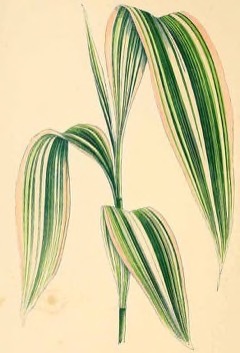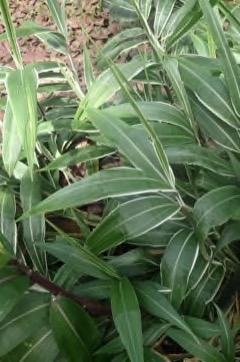 |
|
edibleplants.org |
 |
| Wikimedia.org - Krzysztof Ziarnek, Kenraiz |
Translate this page:
Summary
Physical Characteristics

 Setaria palmifolia is an evergreen Perennial growing to 3 m (9ft) by 2 m (6ft) at a fast rate.
Setaria palmifolia is an evergreen Perennial growing to 3 m (9ft) by 2 m (6ft) at a fast rate.
See above for USDA hardiness. It is hardy to UK zone 10. The flowers are pollinated by Wind.
Suitable for: light (sandy), medium (loamy) and heavy (clay) soils and prefers well-drained soil. Suitable pH: mildly acid, neutral and basic (mildly alkaline) soils. It can grow in semi-shade (light woodland) or no shade. It prefers moist soil and can tolerate drought. The plant can tolerates strong winds but not maritime exposure.
UK Hardiness Map
US Hardiness Map
Synonyms
Agrostis plicata Lour. Chaetochloa effusa (E.Fourn.) Hitchc. Chaetochloa palmifolia (J.König) Hitchc. & Chase Chaetochloa sulcata (Aubl.) Hitchc. Chamaeraphis effusa (E.Fourn.) Kuntze Chamaeraphis nepalensis (Spreng.) Kuntze Chamaeraphis neurodes (F.W.Schultz) Kuntze Chamaeraphis palmifolia (K.D.Koenig) Kuntze Chamaeraphis paniculifera (Steud.) Kuntze Chamaeraphis sulcata (Aubl.) Kuntze Panicum amplissimum Steud. Panicum kleinianum Nees ex Andersson Panicum lene Steud. Panicum mexicanum Scribn. & Merr. Panicum nepalense Spreng. Panicum nervosum Roxb. Panicum neurodes Schult. Panicum palmatum R.Schleich. Panicum palmifolia J.König Panicum palmifolium J. König Panicum paniculiferum Steud. Panicum plicatum Roxb. Panicum plicatum Willd. Panicum sulcatum Aubl. Setaria effusa E.Fourn. Setaria lenis (Steud.) Miq. Setaria paniculifera (Steud.) E.Fourn. Setaria sulcata (Aubl.) Desv.
Plant Habitats
Edible Uses
Edible Parts: Seed Shoots
Edible Uses:
Seeds - boiled or roasted and used as a substitute for rice[301 ]. The hearts of young shoots can be eaten raw, steamed or cooked with rice[301 ]. Very young plants are eaten raw as a side dish with rice[301 ].
References More on Edible Uses
Medicinal Uses
Plants For A Future can not take any responsibility for any adverse effects from the use of plants. Always seek advice from a professional before using a plant medicinally.
The plant is used medicinally[266 ].
References More on Medicinal Uses
The Bookshop: Edible Plant Books
Our Latest books on Perennial Plants For Food Forests and Permaculture Gardens in paperback or digital formats.

Edible Tropical Plants
Food Forest Plants for Hotter Conditions: 250+ Plants For Tropical Food Forests & Permaculture Gardens.
More

Edible Temperate Plants
Plants for Your Food Forest: 500 Plants for Temperate Food Forests & Permaculture Gardens.
More

More Books
PFAF have eight books available in paperback and digital formats. Browse the shop for more information.
Shop Now
Other Uses
Cultivated as an ornamental plant for its palm-like pleated leaves. A folk belief in Taiwan holds that the number of latitudinal creases on the leaf predicts the number of typhoons that will hit the area in the coming or current typhoon season. It is known locally as typhoon grass.
Special Uses
Carbon Farming
References More on Other Uses
Cultivation details
Management: Coppice Management: Standard Regional Crop Staple Crop: Balanced carb
Prefers a well-drained but moisture-retentive fertile soil[200 ]. Established plants are drought tolerant[423 ]. The plant has become a weed in many tropical areas[423 ].
Carbon Farming
-
Management: Coppice
Cut to the ground repeatedly - resprouting vigorously. Non-destructive management systems maintaining the soil organic carbon.
-
Management: Standard
Plants grow to their standard height. Harvest fruit, seeds, or other products. Non-Destructive management systems.
-
Regional Crop
These crops have been domesticated and cultivated regionally but have not been adopted elsewhere and are typically not traded globally, Examples in this broad category include perennial cottons and many nuts and staple fruits.
-
Staple Crop: Balanced carb
(0-15 percent protein, 0-15 percent oil, with at least one over 5 percent). The carbohydrates are from either starch or sugar. Annuals include maize, wheat, rice, and potato. Perennials include chestnuts, carob, perennial fruits, nuts, cereals, pseudocereals, woody pods, and acorns.
References Carbon Farming Information and Carbon Sequestration Information
Temperature Converter
Type a value in the Celsius field to convert the value to Fahrenheit:
Fahrenheit:
The PFAF Bookshop
Plants For A Future have a number of books available in paperback and digital form. Book titles include Edible Plants, Edible Perennials, Edible Trees,Edible Shrubs, Woodland Gardening, and Temperate Food Forest Plants. Our new book is Food Forest Plants For Hotter Conditions (Tropical and Sub-Tropical).
Shop Now
Plant Propagation
Seed - Division.
Other Names
If available other names are mentioned here
Short pitpit, Pleated pigeon-grass, Agusahis, Ayas-as, Highland pitpit, Lachang, Luluwan kebo, Palm grass, Zong ye gou wei cao, Palmgrass, hailans pitpit, broadleaved bristlegrass, knotroot. In Spanish it is called pasto de palma and in Samoan vao 'ofe 'ofe.
Native Range
TEMPERATE ASIA: China (Anhui Sheng, Fujian Sheng, Guangdong Sheng, Guangxi Zhuangzu Zizhiqu, Guizhou Sheng, Hainan Sheng, Hubei Sheng, Hunan Sheng, Jiangxi Sheng, Sichuan Sheng, Xizang Zizhiqu, Yunnan Sheng, Zhejiang Sheng), Japan (Kyushu (south), Okinawa, Ryukyu Islands), Taiwan TROPICAL ASIA: Bhutan, India (Arunachal Pradesh, Assam, Bihar, Meghalaya, Mizoram, Nagaland, Odisha, Tripura, West Bengal, Manipur, Sikkim), Sri Lanka, Nepal, Pakistan, Papua New Guinea, Cambodia, Laos, Myanmar, Thailand, Vietnam, Indonesia, Malaysia, Philippines AFRICA: Kenya, Uganda, Liberia, Zimbabwe
Weed Potential
Right plant wrong place. We are currently updating this section.
Please note that a plant may be invasive in one area but may not in your area so it's worth checking.
The plant has become a weed in many tropical areas[423 ]. Palm grass can form a total ground cover, preventing the growth and establishment of seedlings of any other species. Invasive, species in Australia, New Zealand, many Pacific Islands, and the Americas.
Conservation Status
IUCN Red List of Threatened Plants Status : This taxon has not yet been assessed

Growth: S = slow M = medium F = fast. Soil: L = light (sandy) M = medium H = heavy (clay). pH: A = acid N = neutral B = basic (alkaline). Shade: F = full shade S = semi-shade N = no shade. Moisture: D = dry M = Moist We = wet Wa = water.
Now available:
Food Forest Plants for Mediterranean Conditions
350+ Perennial Plants For Mediterranean and Drier Food Forests and Permaculture Gardens.
[Paperback and eBook]
This is the third in Plants For A Future's series of plant guides for food forests tailored to
specific climate zones. Following volumes on temperate and tropical ecosystems, this book focuses
on species suited to Mediterranean conditions—regions with hot, dry summers and cool, wet winters,
often facing the added challenge of climate change.
Read More
Expert comment
Author
(J.König) Stapf
Botanical References
Links / References
For a list of references used on this page please go here
A special thanks to Ken Fern for some of the information used on this page.
Readers comment
| Add a comment |
|
If you have important information about this plant that may help other users please add a comment or link below. Only comments or links that are felt to be directly relevant to a plant will be included. If you think a comment/link or information contained on this page is inaccurate or misleading we would welcome your feedback at [email protected]. If you have questions about a plant please use the Forum on this website as we do not have the resources to answer questions ourselves.
* Please note: the comments by website users are not necessarily those held by PFAF and may give misleading or inaccurate information.
To leave a comment please Register or login here All comments need to be approved so will not appear immediately.
|
Subject : Setaria palmifolia
|
|
|
|